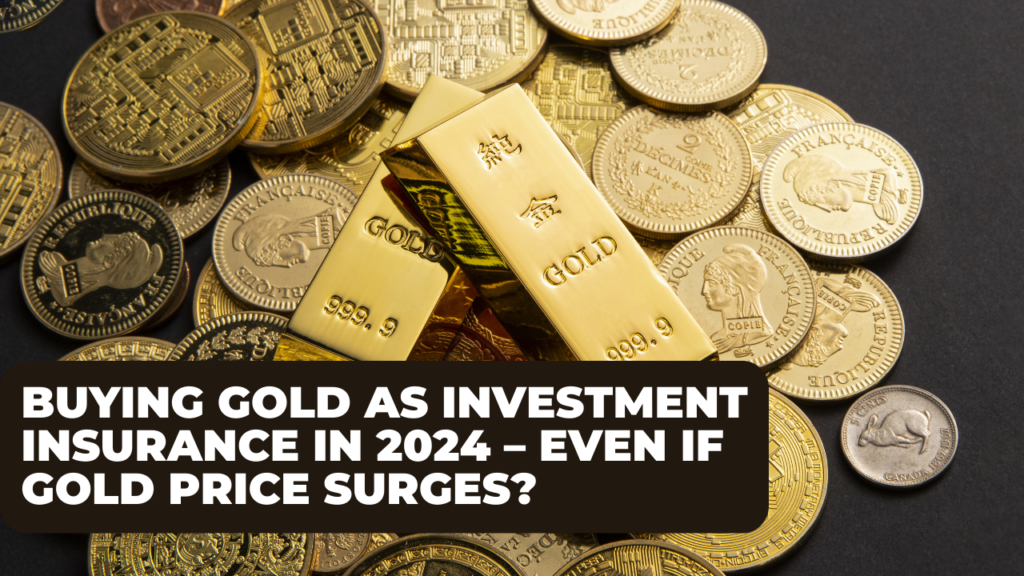Buying Gold as Investment Insurance in 2024 – Even if Gold Price Surges?

“Dive into the world of gold investments with our guide, ‘Buying Gold as Investment Insurance in 2024 – Even if Gold Price Surges?’ Uncover strategies, a key number, and insightful tips to navigate the gold market. Discover how gold can act as your financial safeguard and the number you need for success. Invest wisely, secure your wealth!”
Gold is the ultimate representation of stability and wealth in the ever changing world of investments. Gold’s ageless appeal never fails to enthrall investors, whether they are in the glittering markets of India or the financial titans of the world. The prices of 22 and 24 carat gold, trends in gold exchange-traded funds (ETFs), best practices for international investors, tax implications, real-world success stories, and the tactical placement of gold in investment portfolios are just a few of the many topics covered in this article that explores the complex world of gold investments.
Table of Contents
ToggleGold Price for 22 and 24 K in India and United States:
For centuries, gold has been a vital component of wealth preservation due to its attractive luster. The price of gold in India, whether it is 22 or 24 carats, varies according to a number of factors such as international demand, economic indicators, and geopolitical developments. Right now, market forces continue to affect prices, which presents investors with both opportunities and challenges. Buying Gold as Investment Insurance in 2024 – Even if Gold Price Surges? See the last 15 years Gold Price Chart below:
Year | Gold Price Per Ounce in USD | Gold Price (24 Karat) Per 10 Gram in INR |
2024 (Till Today) | $2,050.81 | Rs. 65,285.00 |
2023 | $1,943.00 | Rs.65,330.00 |
2022 | $1,801.87 | Rs.52,670.00 |
2021 | $1,798.89 | Rs.48,720.00 |
2020 | $1,773.73 | Rs.48,651.00 |
2019 | $1,393.34 | Rs.35,220.00 |
2018 | $1,268.93 | Rs.31,438.00 |
2017 | $1,260.39 | Rs.29,667.50 |
2016 | $1,251.92 | Rs.28,623.50 |
2015 | $1,158.86 | Rs.26,343.50 |
2014 | $1,266.06 | Rs.28,006.50 |
2013 | $1,409.51 | Rs.29,600.00 |
2012 | $1,668.86 | Rs.31,050.00 |
2011 | $1,573.16 | Rs.26,400.00 |
2010 | $1,226.66 | Rs.18,500.00 |
2009 | $973.66 | Rs.14,500.00 |
Trends in the Investing in Gold ETFs in India and Worldwide:
Exchange-traded funds, or ETFs, have become a well-liked option for investors looking to gain exposure to precious metals without having to deal with the hassles of physical ownership in recent years. Investments in gold exchange-traded funds (ETFs) have increased significantly in Europe, Japan, the US, India, and Canada. Because of their liquidity, ease of trading, and real-time gold price tracking capabilities, Gold ETFs are becoming a popular choice for both novice and experienced investors. Read more such article on Vantage Vista Blog.
Country | Gold ETF | Ticker Symbol | Asset Management Company | Expense Ratio |
India | SBI Gold ETF | SBIGOLDETF | SBI Mutual Fund | 0.55% |
India | HDFC Gold ETF | HDFCGOLDETF | HDFC Mutual Fund | 0.50% |
India | ICICI Prudential Gold ETF | ICICIGOLDETF | ICICI Prudential AMC | 0.55% |
India | Axis Gold ETF | AXISGOLDETF | Axis Mutual Fund | 0.50% |
India | Kotak Gold ETF | KOTAKGOLDETF | Kotak Mahindra Mutual Fund | 0.50% |
USA | SPDR Gold Shares | GLD | State Street Global Advisors | 0.40% |
USA | iShares Gold Trust | IAU | BlackRock | 0.25% |
USA | VanEck Vectors Gold Miners | GDX | VanEck | 0.52% |
USA | Aberdeen Standard Gold ETF | SGOL | Aberdeen Standard Investments | 0.17% |
USA | Invesco QQQ Trust | QQQ | Invesco | 0.20% |
Japan | WisdomTree Japan Equity | 167101.T | WisdomTree | 0.50% |
Japan | Nomura TOPIX-17 Gold ETF | 1332.T | Nomura Asset Management | 0.55% |
Japan | Daiwa ETF TOPIX Gold | 1326.T | Daiwa Asset Management | 0.50% |
Japan | iShares MSCI Japan ETF | EWJ | BlackRock | 0.50% |
Japan | Mitsubishi UFJ Goldman S. | 1546.T | Mitsubishi UFJ Trust | 0.59% |
Canada | iShares Gold Trust | IAU | BlackRock | 0.25% |
Canada | BMO Equal Weight Gold | ZGD | BMO Asset Management | 0.55% |
Canada | Horizons Gold ETF | HUG | Horizons ETFs | 0.65% |
Canada | CI First Asset Gold+ | FIG | CI Global Asset Mgmt | 0.80% |
Canada | Sprott Physical Gold | PHS | Sprott Asset Mgmt | 0.45% |
Europe | Amundi Physical Gold ETC | GLDA.PA | Amundi | 0.15% |
Europe | Xtrackers Physical Gold ETC | XAD1.DE | DWS Group | 0.15% |
Europe | Invesco Physical Gold ETC | SGLD.L | Invesco | 0.19% |
Europe | iShares Physical Gold ETC | SGLN.L | BlackRock | 0.25% |
Europe | WisdomTree Physical Gold | WGLD.L | WisdomTree | 0.22% |
Buying Gold as Investment Insurance in 2024 – Even if Gold Price Surges?

The Use of Gold in Investment Portfolio Diversification
Adapted tactics are necessary for navigating the global terrain. Investors in the US frequently use Gold ETFs as a hedge against inflation and unstable economic conditions. Diversification may be the main strategy in Japan, but cultural affinities and financial caution may be combined in India. It is essential to comprehend the regional quirks when developing a successful investing plan.
For investors looking for diversification, it is essential to comprehend the place of gold in investment portfolios. According to historical data, gold can serve as a type of “investment insurance,” reducing overall losses during stock, bond, or real estate downturns and acting as a hedge against market volatility.
Gold as Investment Insurance:
Historical data supports gold’s role as a risk-mitigating tool. Acts as a form of “investment insurance” during periods of market uncertainty. Smoothes risk and return, reducing losses when traditional assets face sharp declines.
Research-backed Hedging:
Research indicates that gold consistently hedges investment risk. Positive impact on overall returns during prolonged periods of weak stock markets.
Portfolio Impact:
Evaluate how adding gold to a 60:40 portfolio split between equities and bonds affects risk and reward. Acts as a protective measure, akin to an insurance policy during market downturns.
Cost of Protection:
Acknowledge that the protective benefits of gold come with a small cost during favorable market conditions. Similar to paying premiums for insurance even when there are no immediate risks.
Long-term Returns and Premiums:
Over the past 40 or 20 years, holding gold in a portfolio has resulted in slightly lower overall returns. The “premiums” paid for investment-risk insurance through gold ownership.
Timing Challenges:
Attempting to time the market by buying gold before other assets fall can be challenging. The unpredictability of short-term and long-term investment performance.
Diversification and Uncertainty:
The essence of diversification is reducing uncertainty by owning a range of different assets. Spreading risk across various assets mitigates the potential for catastrophic losses.
Model Portfolios and Re-balancing:
Many financial advisors base model portfolios on a 60:40 equity to bond mix. Periodic re-balancing ensures the preservation of diversification and risk management.
Gold’s Unique Characteristics:
Gold does not pay income and is considered a “non-yielding asset” in financial terms. Reliance on gold price appreciation for gains, distinguishing it from traditional assets.
Whether Time is Right for Gold Investment Strategies:
The timing of gold investments is a perpetual debate. Important factors include the state of the economy, geopolitical developments, and market sentiment. Although gold is frequently regarded as a safe-haven asset in times of crisis, before making big investment decisions, investors should carefully consider their risk tolerance and conduct in-depth research.
Diverse Independence:
Gold prices showcase minimal correlation with other asset classes. Serves as a shield, moving independently and mitigating the impact of losses in a diversified portfolio. Among 17 major assets, only a select few, including the US Dollar, exhibit smaller correlations over the last 5 years.
Skewing Towards Growth:
Gold’s prices ascend at a faster pace than their descent. Positive skewness enhances its role in swiftly counteracting losses, offering a distinctive advantage compared to traditional stock markets.Unveils a unique dynamic that sets it apart in the realm of investment.
Liquidity Unleashed:
Physical gold boasts deep liquidity and is a highly traded global asset. Ranks as the fourth largest FX pair globally if treated as a currency.Continuous trading nearly 24 hours a day from Asia to the US ensures unparalleled liquidity and accessibility.
Global Allure:
Gold commands diverse demand globally, attracting investors, electronics manufacturers, and central banks. Seasonal events, from weddings to festivals, contribute to its varied user-base.A resilient force providing stability amid market fluctuations.
Currency Immunity:
Gold’s value transcends reliance on any specific currency, offering a robust defense against currency crises. Quoted in various currencies, it inherently preserves value against the backdrop of diverse monetary forms. A steadfast asset for safeguarding against inflation and currency-related uncertainties.
Gold ETF and Taxation, Subsidies, or Other Benefits:
Investors often wonder about the taxation implications of Gold ETFs. The tax treatment varies across countries, and understanding these nuances is imperative. Some jurisdictions may offer subsidies or benefits for gold investments, making it essential for investors to explore the financial advantages associated with their specific region.
Advice for Gold Investment as Diversification for Millennials:
Gold is a classic and tangible asset for millennials looking to diversify their investment portfolios. It is a useful supplement to a diversified investment plan because of its capacity to function as a hedge against inflation and market volatility. Gold ETFs provide young investors with an affordable and convenient way to get started in the world of precious metal investing.
Case Study of Gold Investment and Benefits in Japan Housewives:
In Japan, a noteworthy case study involves housewives who turned to gold as a stable investment amidst economic uncertainties. By strategically allocating a portion of their savings to gold, these individuals secured a financial cushion and a means of preserving wealth over the long term.
Case Study of Systematic Gold Investment by Indians:
In India, systematic gold investment through instruments like Gold ETFs and sovereign gold bonds has gained popularity. This approach allows investors to accumulate gold over time, benefitting from rupee cost averaging and shielding themselves from the volatility associated with lump-sum investments.
Case Study of Gold Investment as Stabilizer Against Equity and Bonds Across the Globe:
Global investors often use gold as a stabilizer in their portfolios, especially during market volatility. A case study examining how gold investments act as a counterbalance to equities and bonds can shed light on its role in achieving a diversified and resilient investment portfolio.
Buying Gold as Investment Insurance in 2024 – Even if Gold Price Surges? Conclusion:
The historical data, unique attributes, and success stories underscore the enduring value of gold in diverse investment portfolios. Gold, a timeless symbol of wealth, continues to provide investors navigating the intricacies of the constantly changing financial landscape with a stable and dependable option.
The precious metal continues to influence investors’ financial futures, as evidenced by the shifting gold prices in India and the growing acceptance of gold exchange-traded funds (ETFs) across the globe. The appeal of gold endures despite market volatility and economic uncertainty because it provides a glimpse of stability and wealth preservation that cuts across national boundaries. Whether it’s the prudent housewives in Japan or the savvy investors in India, the golden path to financial triumph awaits those who navigate it with wisdom and foresight.

Leave a Reply